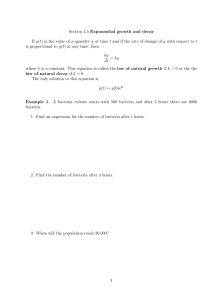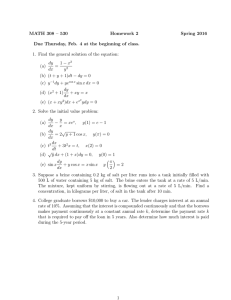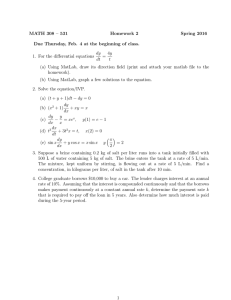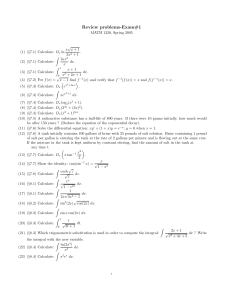A-12 Pickle Fermentation
advertisement
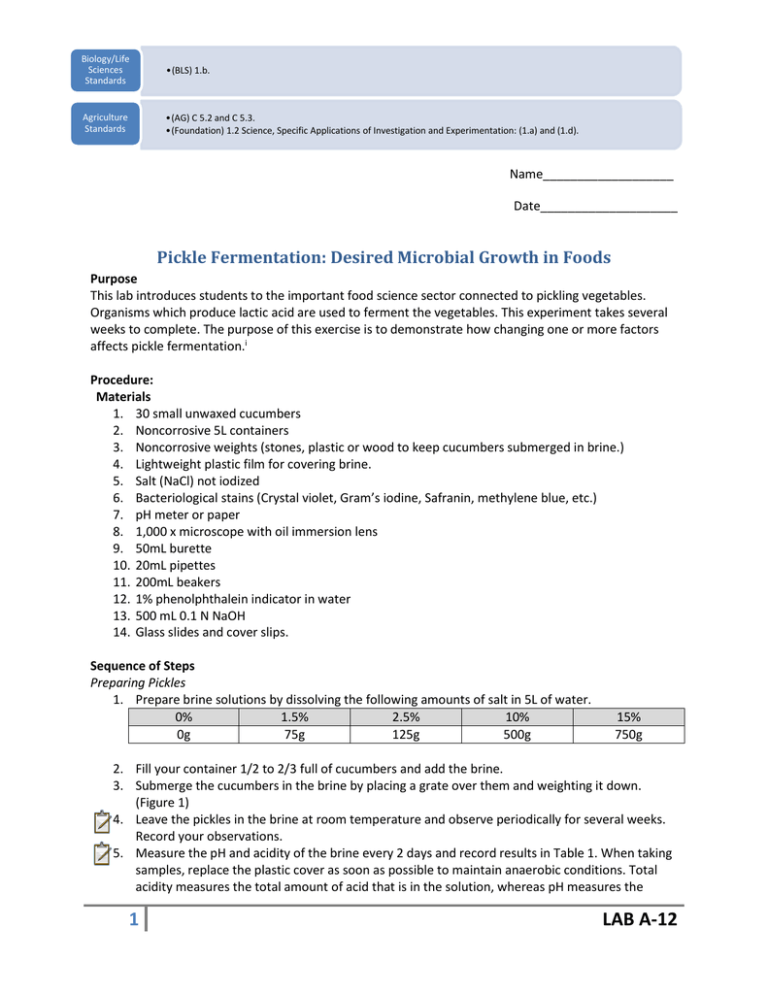
Biology/Life Sciences Standards •(BLS) 1.b. Agriculture Standards •(AG) C 5.2 and C 5.3. •(Foundation) 1.2 Science, Specific Applications of Investigation and Experimentation: (1.a) and (1.d). Name___________________ Date____________________ Pickle Fermentation: Desired Microbial Growth in Foods Purpose This lab introduces students to the important food science sector connected to pickling vegetables. Organisms which produce lactic acid are used to ferment the vegetables. This experiment takes several weeks to complete. The purpose of this exercise is to demonstrate how changing one or more factors affects pickle fermentation.i Procedure: Materials 1. 30 small unwaxed cucumbers 2. Noncorrosive 5L containers 3. Noncorrosive weights (stones, plastic or wood to keep cucumbers submerged in brine.) 4. Lightweight plastic film for covering brine. 5. Salt (NaCl) not iodized 6. Bacteriological stains (Crystal violet, Gram’s iodine, Safranin, methylene blue, etc.) 7. pH meter or paper 8. 1,000 x microscope with oil immersion lens 9. 50mL burette 10. 20mL pipettes 11. 200mL beakers 12. 1% phenolphthalein indicator in water 13. 500 mL 0.1 N NaOH 14. Glass slides and cover slips. Sequence of Steps Preparing Pickles 1. Prepare brine solutions by dissolving the following amounts of salt in 5L of water. 0% 1.5% 2.5% 10% 0g 75g 125g 500g 15% 750g 2. Fill your container 1/2 to 2/3 full of cucumbers and add the brine. 3. Submerge the cucumbers in the brine by placing a grate over them and weighting it down. (Figure 1) 4. Leave the pickles in the brine at room temperature and observe periodically for several weeks. Record your observations. 5. Measure the pH and acidity of the brine every 2 days and record results in Table 1. When taking samples, replace the plastic cover as soon as possible to maintain anaerobic conditions. Total acidity measures the total amount of acid that is in the solution, whereas pH measures the 1 LAB A-12 hydrogen ion concentration of the solution, which is related to how strong the acid concentration is. Measure the total acidity by either titration or use of a pH meter as described below. Titration Method 1. In this method, brine is titrated with phenolphthalein until the endpoint (a faint pink color which remains for 15 sec) is reached. 2. Pipette 18mL of brine into a 100mL glass beaker. 3. Add 0.5mL of a 1% phenolphthalein solution (1-2 drops). 4. Titrate with 0.1 N NaOH until the endpoint is reached. 5. Record the number of mL of 0.1 N NaOH required. 6. Then calculate the total acidity (as acetic acid) as follows % acidity = (mL of NaOH) x 0.009 x 100 Sample weight in g Since we use an 18g sample, this can be simplified to: % acidity = (mL of NaOH) / 20 pH Method 1. In this method, pH is measured using a pH meter or pH paper. 2. Standardize pH meter using pH 7 and pH 11 buffer standards. 3. Place 50mL of brine in a 200mL beaker. 4. Place a stirring bar gently into the beaker and place it on an automatic stirrer or manually stir with a rod. 5. Titrate with 0.1 N NaOH to pH 8.1 using the pH meter. 6. Record data as mL of 0.1 N NaOH added. 7. Calculate the total acidity using the equation used in the titration method. Microbial Analysis 1. Make visual and microbial observations every 5 days and record the results in Table 1. 2. Follow the presence and succession of various types of microorganisms (molds, yeast, spherical bacteria in chains, rod-shaped bacteria, rod shaped bacteria in chains, etc.) by taking samples of the brine, staining them, and viewing the sample under a microscope. Preparation of Smears 1. Pure cultures of bacteria can ordinarily be prepared for staining by the simple process of making an aqueous suspension and drying a drop of it on a slide or cover glass. 2. To prepare a bacterial smear, remove a small amount of surface growth from the brine and mix it with distilled water. 3. The suspension used should always be sufficiently dilute. (If a smear does not show well separated bacteria, a more dilute smear should be made.) 4. Fix the suspension to the slide by drying it on a hot plate and then passing it rapidly through a Bunsen flame 2 or 3 times. Staining Procedure 1. Bacteria can be differentiated into Gram-positive bacteria and Gram-negative bacteria by the using this procedure. 2. Fix the dilute brine solution onto a clean slide as described above. 2 LAB A-12 3. Place a few drops of Crystal Violet Stain on the slide and let it stand for 60 seconds. Drain the extra stain from the slide. 4. Place a few drops of Iodine Stain on the slide and let it stand for 60 seconds. 5. Drain the extra stain and wash with water until no free stain appears in the wash. 6. Gently wash with 95% alcohol until no free stain appears in the wash. 7. Place a few drops of Safranin on the slide and let it stand for 45 seconds. 8. Drain the extra stain from the slide and wash with water until no free stain appears in the wash. 9. Air dry the slide and examine it under the microscope. 10. Gram-positive bacteria have the ability to retain Crystal Violet stain and will appear dark purple under the microscope. 11. Gram negative bacteria lose their ability to retain Crystal Violet stain when rinsed with alcohol. They are made visible by the Safranin and will appear pink. **Caution! Do not eat the pickles you produced in this experiment! Control of or elimination of pathogenic bacteria cannot be guaranteed by these processing techniques!** Figure 1 Table 1 Sample 0% Salt Date: pH Acidity Date: pH Acidity Date: pH Acidity Date: Microbial Date: Visual 1.5% Salt 2.5% Salt 10% Salt 15% Salt 3 LAB A-12 Observations Keep track of notable observations (not recorded in the table) below: Questions 1. Do the same types of microorganisms appear (predominate) in all containers? 2. Are some groups present only in one container? Why or why not? 3. Were you able to absolutely exclude the growth of microorganisms using very high levels of salt? Why or why not? 4. Why are fermented pickles desalted before packaging for consumers? 5. What is the role of salt in food preservation? 6. How do the two methods for producing pickles (the brine process and the fresh-pack process) differ? 4 LAB A-12 Notes for the Teacher 1. Do the same types of microorganisms appear (predominate) in all containers? A particular organism will predominate throughout the fermentation process. However, which organisms predominates will depend on the stage of the fermentation process. As different carbohydrates become available or unavailable, the predominating organism will change. 2. Are some groups present only in one container? Why or why not? Yes, some bacteria are more salt tolerant than others. Bacteria differ as to the type of carbohydrates they use as food, and their populations will therefore change as the food supply changes during the fermentation process. 3. Were you able to absolutely exclude the growth of microorganisms using very high levels of salt? Why or why not? Probably not, since some bacteria are extremely salt tolerant and will still survive at high levels of salt. 4. Why are fermented pickles desalted before packaging for consumers? The high salt content of the brine and pickles would probably be offensive to most people. 5. What is the role of salt in food preservation? Salt preserves food by lowering the amount of “free” water molecules. Without enough free water, microorganisms cannot grow well. 6. How do the two methods for producing pickles (the brine process and the fresh-pack process) differ? In the brine process, pickles are immersed in brine for several weeks. Fermentation is accomplished by lactic acid bacteria. The process provides a characteristic flavor. The high salt content of the brine and the use of a cover to keep air out of the container reduce undesirable microbial growth. In the fresh-pack process, the pickles are in brine for only several hours, and heat treatment (immersion in a boiling solution of vinegar and pickling spices) preserves the product and imparts flavor. i Dalmasso, Dr. Joseph (2001).Desirable Microbial Growth in Foods: Pickle Fermentation. Institute of Food Technologists; The Society for Food Science and Technology 5 LAB A-12

